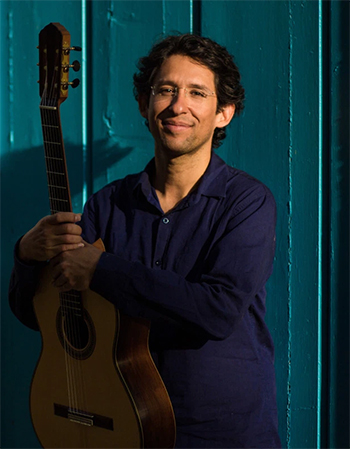by Nicholas Stevens

Pablo Garibay, doubly rare as a star who started late and a guitarist known for concerto performances, made his Cleveland debut on the Guitar Society’s 2019-2020 International Series. According to executive director Erik Mann, the group had to enlist Congresswoman Marcia Fudge as an advocate in helping the Mexican musician obtain a visa for the visit.
CCGS foregrounds its educational activity, even in concerts. No exception, this evening began with an arrangement of a Mexican folk song as performed by the Cleveland School of the Arts Guitar Quartet. Impressive as individuals and harmonious as an ensemble, the students handled delicate harmonics, bright strumming, dynamic contrast, and percussive effects with both focus and a sense of fun.
Tuxedo-clad, always careful to tune and take a moment to think before plunging in, Garibay both looks and sounds meticulous. His strengths emerged in the first half: a concern for lifting important tunes out of dense textures, and a deftness in suddenly shifting tone.
A gorgeous melody splays out in “Canción de Cuna,” the first of Leo Brouwer’s Dos Temas Populares Cubanos, after a muted near-quotation of Bach. His right palm floating inches from the strings, Garibay chose individual notes here and there for emphasis: one came with a singing vibrato. “Ojos Brujos,” rendered with a deliberation that gave way to deepening passion, bore an after-the-fact dedication to Garibay’s eight-month-old daughter.
Simone Iannarelli’s The Last Coffee Together, informed by popular and film music, has a trick up its sleeve: its chord progression shifts in time whenever it recurs, reflecting changing emotions that accompany added experiences. Garibay made it all sound easy.
The first movement of Manuel M. Ponce’s Sonata III maintains suspense through harmony. Garibay added rhythmic tension as well. As elsewhere, he made sudden changes in timbre sound like pivots into alternate realities. In the second movement, the languid, songlike melody almost took a backseat to the intricate, finely wrought accompaniment figures. Soft humming sounds yielded to sharper tones in the third, despite Garibay making no apparent shift in physical motion.
Any audience member who had wondered how high the guitar could play learned in the first of Eguardo Angulo’s Dos Cadencias, which also contained tasteful percussive effects. The second section drifted along, before the time came for Garibay to play forcefully. His hands became a storm of strums, thorny arpeggios dropped in as though it were easier to play fast than loud.
Garibay established clear layers and maintained a tight focus on details in the first movement of Antonio José’s Sonata, and adopted a buzzing tone for the off-kilter dance of the second. A program note lists Ravel among José’s admirers, and one senses that the feeling was mutual. The influence of the elder artist bleeds through in the slow, anguished strums and funereal grace of the “pavana triste” that constitutes the third movement. An abrupt transition to the finale brought both fierce energy and wistful reminiscences of the first movement.
Garibay’s well-earned encore, a short piece in the style of Venezuelan harp music, bore a dedication to the elementary-school students that Garibay had worked with that week, as well as to the audience. The piece, no less beautiful for its mounting technical complexity, poured forth like much-needed sunshine.
Published on ClevelandClassical.com November 18, 2019.
Click here for a printable copy of this article



